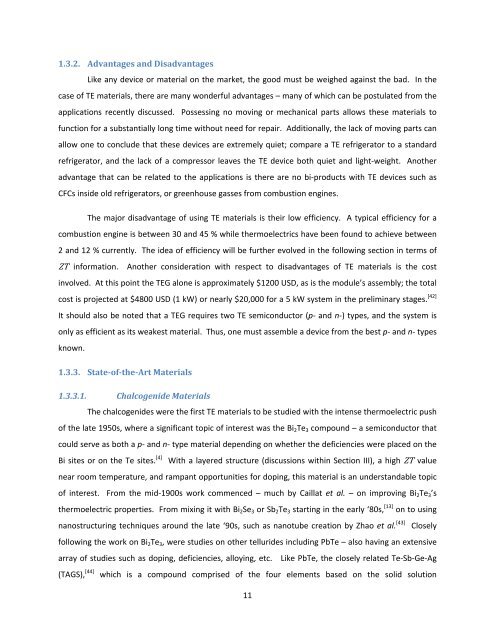Exploration and Optimization of Tellurium‐Based Thermoelectrics
Exploration and Optimization of Tellurium‐Based Thermoelectrics
Exploration and Optimization of Tellurium‐Based Thermoelectrics
Create successful ePaper yourself
Turn your PDF publications into a flip-book with our unique Google optimized e-Paper software.
1.3.2. Advantages <strong>and</strong> Disadvantages<br />
Like any device or material on the market, the good must be weighed against the bad. In the<br />
case <strong>of</strong> TE materials, there are many wonderful advantages – many <strong>of</strong> which can be postulated from the<br />
applications recently discussed. Possessing no moving or mechanical parts allows these materials to<br />
function for a substantially long time without need for repair. Additionally, the lack <strong>of</strong> moving parts can<br />
allow one to conclude that these devices are extremely quiet; compare a TE refrigerator to a st<strong>and</strong>ard<br />
refrigerator, <strong>and</strong> the lack <strong>of</strong> a compressor leaves the TE device both quiet <strong>and</strong> light‐weight. Another<br />
advantage that can be related to the applications is there are no bi‐products with TE devices such as<br />
CFCs inside old refrigerators, or greenhouse gasses from combustion engines.<br />
The major disadvantage <strong>of</strong> using TE materials is their low efficiency. A typical efficiency for a<br />
combustion engine is between 30 <strong>and</strong> 45 % while thermoelectrics have been found to achieve between<br />
2 <strong>and</strong> 12 % currently. The idea <strong>of</strong> efficiency will be further evolved in the following section in terms <strong>of</strong><br />
ZT information. Another consideration with respect to disadvantages <strong>of</strong> TE materials is the cost<br />
involved. At this point the TEG alone is approximately $1200 USD, as is the module’s assembly; the total<br />
cost is projected at $4800 USD (1 kW) or nearly $20,000 for a 5 kW system in the preliminary stages. [42]<br />
It should also be noted that a TEG requires two TE semiconductor (p‐ <strong>and</strong> n‐) types, <strong>and</strong> the system is<br />
only as efficient as its weakest material. Thus, one must assemble a device from the best p‐ <strong>and</strong> n‐ types<br />
known.<br />
1.3.3. State‐<strong>of</strong>‐the‐Art Materials<br />
1.3.3.1. Chalcogenide Materials<br />
The chalcogenides were the first TE materials to be studied with the intense thermoelectric push<br />
<strong>of</strong> the late 1950s, where a significant topic <strong>of</strong> interest was the Bi2Te3 compound – a semiconductor that<br />
could serve as both a p‐ <strong>and</strong> n‐ type material depending on whether the deficiencies were placed on the<br />
Bi sites or on the Te sites. [4] With a layered structure (discussions within Section III), a high ZT value<br />
near room temperature, <strong>and</strong> rampant opportunities for doping, this material is an underst<strong>and</strong>able topic<br />
<strong>of</strong> interest. From the mid‐1900s work commenced – much by Caillat et al. – on improving Bi2Te3’s<br />
thermoelectric properties. From mixing it with Bi2Se3 or Sb2Te3 starting in the early ‘80s, [13] on to using<br />
nanostructuring techniques around the late ‘90s, such as nanotube creation by Zhao et al. [43] Closely<br />
following the work on Bi2Te3, were studies on other tellurides including PbTe – also having an extensive<br />
array <strong>of</strong> studies such as doping, deficiencies, alloying, etc. Like PbTe, the closely related Te‐Sb‐Ge‐Ag<br />
(TAGS), [44] which is a compound comprised <strong>of</strong> the four elements based on the solid solution<br />
11
















